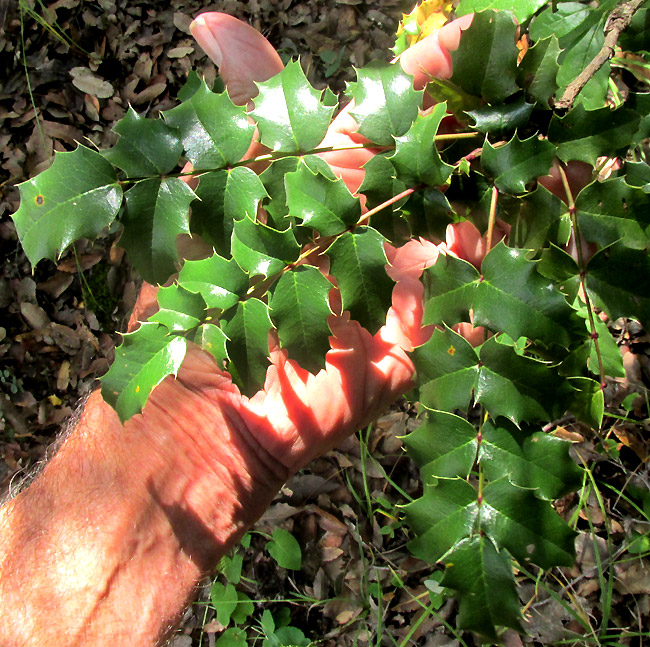Excerpts from Jim Conrad's
Naturalist Newsletter
Entry dated November 10, 2023, from notes taken on ridge with secondary oak forest about 300m west of Cascadas de La Piedad waterfall 3kms NW of the community of San Pablo, municipality of Almeaco de Bonfil; N20.1002°, W100.0067°, elevation 2360 meters (7750ft); extreme southern Querétaro state, MÉXICO
BERBERIS MORANENSIS

The above handsome leaves grew from a branch tip of a small tree about 3m tall (10ft). The tree was so entangled with other bushes and trees that no decent picture of the tree's form was possible. Though the tree bore no flowers or fruits, its leaves were so distinctive that I felt sure it could be identified. At first glance I'd thought it was close to the American Holly tree. However, above we see once-divided compound leaves; the segments with spiny margins are leaflets, not leaves as in holly species. Structurally, this was similar to the abundant Agarita we saw in Texas. That was a kind of barberry, genus Berberis in the Barberry Family, the Berberidaceae.
The 2009 volume of the Flora del Bajío documenting the Barberry Family in our upland, central Mexican region known as the Bajío reports that here only the barberry genus Berberis has been found. In that genus, only eight of Mexico's approximately 40 barberry species have been documented in our area. Here, if your barberry is a small tree with spiny-margined leaves divided into 9-11 leaflets like ours, with only around 5 spiney teeth on each side of the leaflet, you have BERBERIS MORANENSIS, with no English name.
Berberis moranensis is endemic just to Mexico, but within Mexico it's widely distributed in oak, pine and fir forests from the northern Western Sierra Madres south through the highlands of central Mexico, and farther south into upland Oaxaca.
The Flora del Bajío describes Berberis moranensis as a shrub or tree up to 10m tall (33ft) with compound leaves usually developing 7-11 leaflets, but sometimes 5-15. Leaflet margins can bear 4-15 teeth on each side. These are wide-ranging variations in important details. The Flora explains that the species is notably variable throughout its distribution area, and that several varieties have been recognized, but more studies are needed to see if such taxa are valid. I do find expert-identified plants identified as Berberis moranensis with features perfectly matching our tree's.
Currently it remains unclear how the barberry genus Berberis should be defined. Kew's Plants of the World Online database accepts our plant's name Berberis moranensis, but the similarly authoritative GBIF website assigns our plant to a different genus, naming it Mahonia moranensis. In 2017, Chih-Chieh Yu and others published a work entitled "Why Mahonia? Molecular recircumscription of Berberis s.l., with the description of two new genera, Alloberberis and Moranothamnus." After their genetic analysis, they concluded that "... the phylogenetic status of Mahonia and consequently the circumscription of Berberis s.l. remains problematic."
The 2015 study by M.Á. Bello-González and others entitled "Plantas útiles de la comunidad indígena Nuevo San Juan Parangaricutiro, Michoacán, México," describes the aerial parts of Berberis moranensis as used to treat numbness, nausea and vomiting.
Among several Spanish names applied to Berberis moranensis are palo de teñir (dye tree), palo amarillo (yellow tree), and leña amarilla (yellow firewood). These names suggest that traditionally a yellow dye has been derived from the wood. If you viewed the above link to our Agarita page, at the page's bottom you saw Agarita's golden yellow wood, and the rich yellow dye I made from it by letting some woodchips soak in water overnight. Despite my being unable to find mention of the traditional Mexican use of the wood as a yellow dye, with such Spanish names it's clear that such has been the case.